
Last Updated: April 26, 2024
Writing a membership agreement is an important step in setting up an organization. After all, it allows for order in the institution. It also helps ensure your members understand their obligations and duties to the organization as a whole.
But how do you write a membership agreement? Don’t worry because it’s not as difficult as it sounds. You’ll learn some tips for writing one in this article. You’ll also see some examples of membership agreements you can take inspiration from.
Let’s get started!
Key Takeaways
- Membership agreements are vital documents for organizations as they outline the rights, responsibilities, and expectations of both the organization and its members.
- These agreements regulate the organization's affairs, clarify rules and regulations, and establish guidelines for membership conduct and responsibilities.
- A membership agreement typically includes basic information, member benefits, membership duties, organizational rules, termination procedures, and signature requirements.
- The process involves collaborating with team members, clearly stating the purpose of the agreement, outlining member benefits and duties, setting organizational rules, defining termination procedures, and obtaining signatures from all parties involved.
- Membership agreements are legally binding contracts that are enforceable in court, provided they are fair, clear, and mutually agreed upon. However, certain exceptions may render them unenforceable, such as cases involving fraud, duress, or unconscionability.
What Is a Membership Agreement?
A membership agreement is a contractual pact between your organization and its members. It’s a detailed document that explains your organization’s expectations from its members. It also states the organization's obligations to its members.
In other words, a membership agreement highlights the rights and responsibilities of all the parties involved in an organization.
Typically, the agreement will include your organization’s rules, regulations, and other codes of conduct. It will also state the entitlements your members receive and how these will be granted. Additionally, a membership agreement specifies how the parties involved will address conflicts should they arise. It also discusses what happens when the terms of the agreement are broken.
The terms of your membership agreement only become binding after the document has been thoroughly read, understood, and signed by the members of the organization.
The agreement can be distributed physically or digitally, via a pdf agreement or an online membership form that’s hosted on your website. Whichever way you distribute the agreement, note that it is important to receive the signed copy of this document as it may be needed for future reference.
Why You Need a Membership Agreement?
But here’s an important question. What exactly do you need a membership agreement for?
One obvious reason you should have a membership agreement is that it helps people to understand the full effect of being part of your organization. This is the foundation of starting a good relationship with your members. But there are other reasons why you need a membership agreement. Let’s look at some of them:
It helps to regulate your association’s affairs. The agreement allows you to state in plain language, what is allowed or not allowed in your association. This is especially useful for prospective members who may need guidelines on how to comport themselves as members of your association.
For example, The F-suite, an online community of chief financial officers, includes a code of conduct in their membership agreement that forbids members from trying to solicit customers from other members of the organization. They also indicate that members should not make sudden event cancellations after joining the waitlist. By including these terms, the F-suite establishes a standard that regulates what members do and avoids the abuse of the platform.
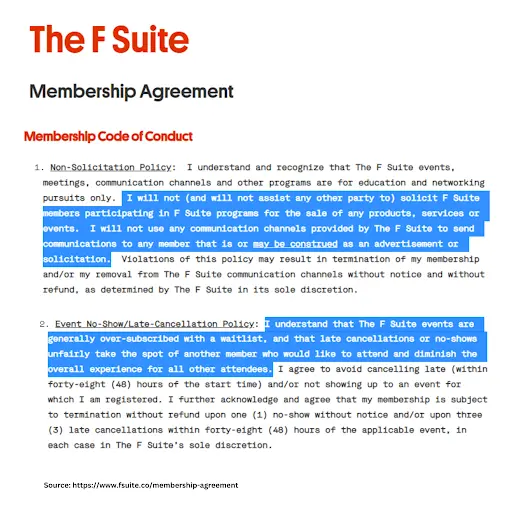
A membership agreement ensures orderlinessThe membership agreement helps to prevent a haphazard approach to dealing with matters pertaining to your organization and its members. This is because there is a laid-out process for dealing with various activities like collecting dues, planning events, sharing information, and so on.
Further, having a membership agreement will instill a sense of responsibility in your members. The agreement is legally binding once it’s signed. With such backup, they’ll be more likely to act in the organization’s best interest.
Finally, the membership agreement is an effective reference point for conflict prevention and resolution. Members of your associations could have concerns about the benefits due to them, offered privileges, the conduct of other members, and so on. When this happens, you can go over the agreement with the concerned parties and address the issue accordingly.
Because a membership agreement is so important, it should be easy to understand. You want to avoid using vague terms and be as specific as possible instead. This will ensure that no one can manipulate your terms and try to exploit the loopholes.
How to Write a Membership Agreement?
Now that you know what a membership agreement is and why you need one, you’ll learn how to create one in six simple steps in this section.
But before we discuss the steps, here’s a tip: don’t embark on this process alone. It’s best if you collaborate with other members of your team, board members, or trusted affiliates to help out. We also recommend seeking legal assistance so that you avoid loopholes as much as possible. You should also make room for amendments, in case new developments arise.
Here are the six steps you need to follow to write a membership agreement:
1. Include Basic Information
If there are any essential facts about LLC resolutions and other contractual agreements like membership agreements you should know about, it’s that they should always contain the basic information of the parties involved. In membership agreements, this includes your organization’s name. This should always be at the top of the document.
The agreement should also have the member’s name. It’s best if you leave blank spaces for this, as seen in the example below. This is so you don’t have to create a new document every time you welcome a new member.
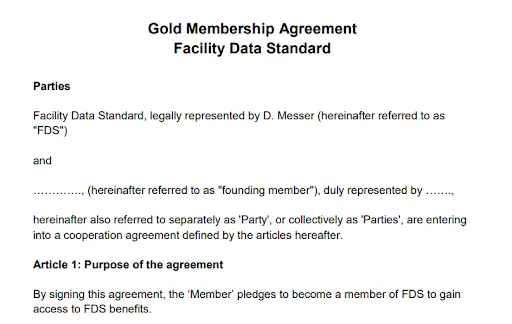
You should also briefly summarize the purpose of the agreement and what its terms entail. If there are unique terms you’ll be using in the agreement, this is also a good place to explain them. See how Business Architecture Guild does this in the example below:
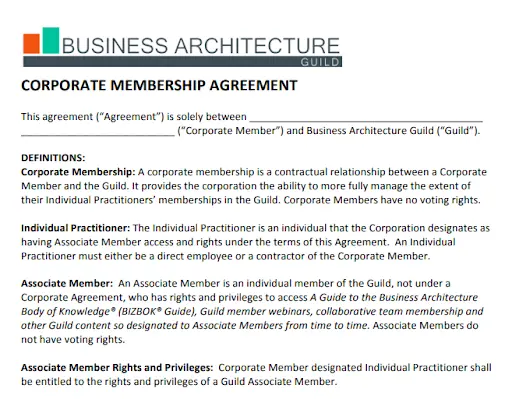
Include the date at which the agreement takes effect, too (either at the top or bottom of the document). Once you have the basics covered, you can move on to the other relevant and more complex details.
2. Address Members' Benefits
In your membership agreement, you need to state the purpose of your organization and what members gain by being a part of it. These are your membership benefits. When working on your membership benefits, you want to be very thorough and leave no room for assumptions.
For instance, will your organization provide any financial assistance to its members? Will they gain more opportunities? Will they get first-hand insights into economic trends? These are the types of information you should include here. Don't hesitate to mention if your membership benefits will be based on tiers or levels.
Here’s another example from the Business Architecture Guild’s membership agreement:
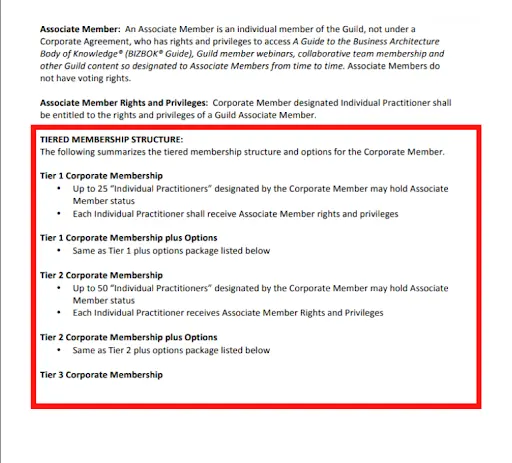
BA Guild is an association that’s made up of corporate and individual members. In the screenshot above of BA Guild’s membership agreement (see content enclosed in a red rectangle), you see the requirements corporate members in each tier must have and the benefits they will enjoy.
The membership agreement also specifies individual members can enjoy (see content outside the red rectangle) — access to their guide, webinars, collaborative team membership, and other content.
Being this detailed will help members have more clarity from the onset and understand what to expect when they join your organization.
3. Outline Membership Duties
No doubt, being a member of your organization will come with responsibilities so feel free to outline them. As you did with the benefits, it’s best to go all out with the duties. If you’re not sure about where to start with this, here are some central ideas:
- Participation: Will you be having physical or virtual meetings that members must attend? If yes, how often must they show up? How active should they be in your community engagements?
- Generosity: Are members expected to pay any dues or fees? How often? Do they have to give donations or volunteer their skills or services for your organization?
- Compliance: Are they expected to adhere to any other guidelines besides the membership agreement?
- Publicity: Are your organization members expected to spread the word about your activities?
These are the basics, but you want to ensure that the members understand the level of commitment and obligations you expect from them from the onset. Here’s an example from the RapidIO Trade Membership agreement:
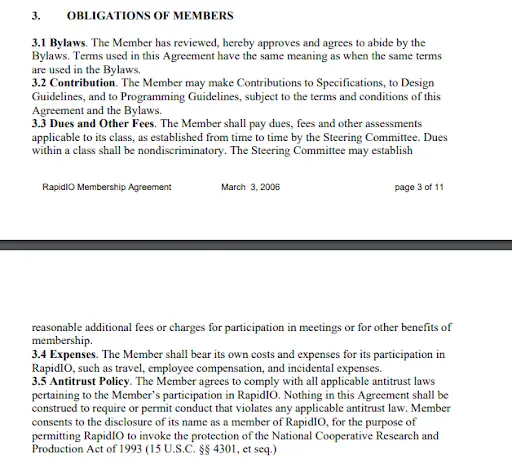
When outlining duties for your association members, ensure that you understand the type of people or corporations you cater to. This way you’ll avoid setting expectations that are unrealistic or that will discourage people from joining your organization.
Also, if your organization’s membership comes at a fee, endeavor to help members understand the pricing model you adopt.
4. Set Organizational Rules
Now, it’s time to set the rules. Your rules should apply to both the members and the organization’s executives. You should also indicate the penalties for any failure to comply. A few things to note when setting rules:
The rules should protect the rights and convenience of all members of the organization. It should clearly indicate how members ought to conduct themselves. The rules you set must also align with your organization's purpose just like the F Suite example, we saw earlier:
Like F-Suite, your association may be strictly for educating members, sharing industry-relevant information, and creating networking opportunities. In this case, you may choose to indicate if your members are allowed to network with other members by sharing their physical or digital business card details.
Are they permitted to seek customers from the organization or recommend business dealings? What should the limit of their relationship with other members be?
In your agreement, you should demand that each member take the privacy and safety of other members seriously. Ask members to be prudent in their dealings, too.
You also want to include that your organization is not liable for any misconduct from its members. This will save your association and its members from bearing the brunt of another person’s carelessness.
However, be sure to state disciplinary actions for such occurrences. This shows the members what measures you’re taking to ensure their safety and will discourage any misbehavior.
5. Describe How Terminations Work
Including a provision for the termination in your membership agreement helps you create a member community that is fair.
But for you to be fair, you want to be clear about the actions that will warrant the termination of membership in the first place. You should also mention that members can choose to terminate the membership of their own volition. In this case, specify that members need to provide formal notice. See this example from Building SMART International:

As seen in the example above, you also want to mention what happens after the termination takes effect. Will the membership fees be refunded? What happens to outstanding payments? Do ex-members still get access to any of the benefits or resources? These are some key things to cover when including a termination clause in your agreement.
6. Request Signature/s
The signature seals the deal. Your membership agreement should have a blank space for members to sign. This should be at the bottom of the document because they’re required to sign after reading.
The member’s signature is technically an acknowledgment that they agree to your organization’s terms. But even then, you should include a statement that the member has read and agreed to the terms stated in the agreement.
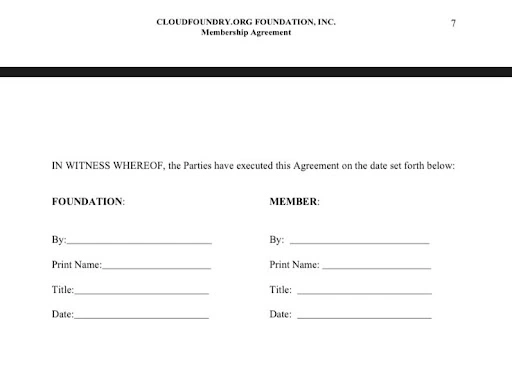
Your organization’s members aren’t the only ones who should sign your membership agreement. Like CloudFoundry.org Foundation, you should input a signature field for your organization as well. Once signed, the agreement becomes legally binding.
What Are the Common Terms and Conditions in a Membership Contract Agreement?

The membership agreement outlines the rights of both the organization and the member joining. Therefore, it includes clauses and terms that are mutually beneficial. Typically, a membership agreement includes the following terms and conditions:
- Definitions and Interpretation: Key terms are clearly defined, as well as how they will be interpreted within the agreement.
- Membership Services: The services or benefits members will receive upon joining are specified.
- Membership Fees: The fees associated with membership, including payment terms and schedules outlined.
- Term and Termination: The duration of the membership and the conditions under which it may be terminated are defined.
- Renewal: The process for renewing membership at the end of the term is explained.
- Member Conduct and Responsibilities: The expected behavior and obligations of members are detailed.
- Limitation of Liability: The extent to which the organization is liable for any damages or losses incurred by members is clarified.
- Dispute Resolution: Procedures for resolving disputes between the organization and its members provided.
- Miscellaneous Provisions: Any additional clauses or provisions relevant to the membership agreement are included.
- Entire Agreement: The membership agreement constitutes the entire understanding between the organization and its members, superseding any prior agreements or understandings confirmed.
Are Membership Agreements Legally Binding?
Yes, most of the time, membership agreements are legally binding contracts because they bind two parties to a term sheet and require them to abide by certain rules.
However, membership agreements are considered enforceable in a court of law because they are mutual agreements between two parties, with all terms decided and mentioned.
Nonetheless, there may be exceptions where they are not enforceable, such as instances of fraud, duress, or unconscionability.
Download Free Membership Agreement Template
As described earlier, a membership agreement outlines the terms and conditions of membership and how both parties, the organization, and the member, will adhere to these terms. To provide you with a clearer understanding, we have included pre-written examples of membership agreements.
You can download them from the links provided below to review:
Feel free to download and review these examples to gain insight into the structure and content of a typical membership agreement.
In Closing
A membership agreement is one of the vital documents you need for your organization. It helps you set a clear path for your affairs and maintain order in your dealings. The membership agreement is also a useful reference point for conflict resolution. If you run a membership-based organization or association, having a membership agreement will save you a lot of trouble in coordinating your activities.
In this post, you learned how to create an effective membership agreement in six simple steps.
First, you need to cover the basics as a foundation for the rest of your agreement. Next, address members’ benefits.
Additionally, you should outline the membership duties and responsibilities so that everyone is clear about expectations. You also need to set rules so members know how to conduct themselves. Include terms that govern how termination works in your organization. Finally, have all parties sign the agreement.
Now you can create a membership agreement that keeps your organization going. Good luck!



